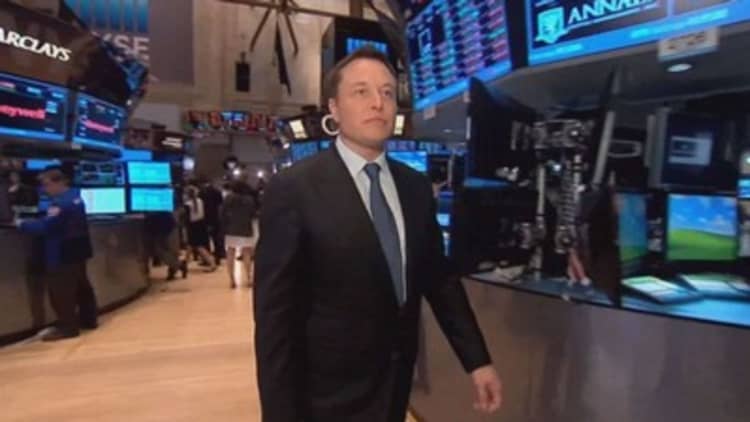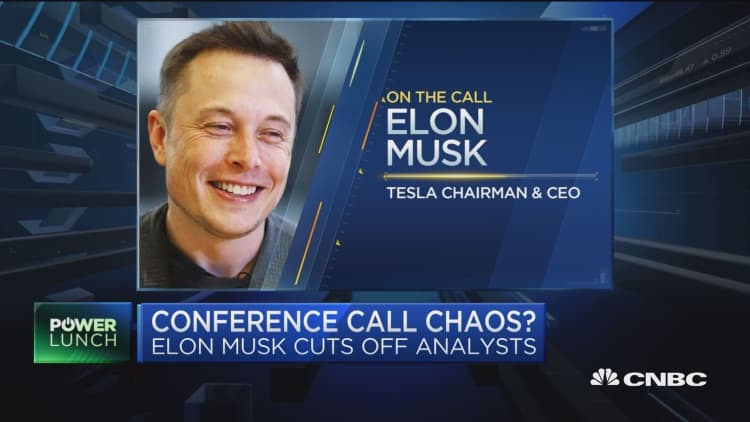Tesla has had at least four fires in the paint shop at its Fremont, California, factory since 2014, according to five people familiar with operations at that plant.
One previously reported fire, in April, was serious enough to stop Model 3 production for multiple shifts that week, these people said. Another fire took place in January 2016 and caused at least a day of suspended vehicle production. Both fires damaged expensive equipment.
These people blamed the fires in part on improper cleaning, maintenance and insufficient training for new employees in the face of high pressure to meet production goals. Two current employees said they were concerned about their health because of fire hazards and poor air quality. All the people agreed that the April fire contributed to slowing down Model 3 production.
A Tesla spokesperson denied that the April fire was "significant" or had any impact on Model 3 production, and said:
"In recent months, we have further enhanced the safety and efficiency of our paint shop, including significant upgrades to equipment, as well as an extensive maintenance effort involving cleaning and calibration. In order to protect the health of our employees, we also conduct regular air monitoring and have proper ventilation and personal protective equipment for everyone who works in the paint shop."
Tesla's future as a mass-market carmaker hinges on efficient, high volume production of the Model 3, the company's lowest-priced offering so far. When Tesla unveiled the Model 3 in 2016, CEO Elon Musk said it would be able to produce 100,000 to 200,000 Model 3 cars by the end of 2017 with a base price of $35,000.
Instead, Tesla produced just 2,685 Model 3s in total for all of 2017.
Tesla also missed its goal of producing 2,500 Model 3s per week by March 31, 2018. So far, the company has sold only premium versions of the Model 3, which cost $44,000 to $78,000.
Paint shop issues are still hampering Tesla's progress with Model 3 production, according to current employees and other people familiar with Tesla's paint shop. They requested anonymity because they have not been authorized to speak to the media.
April fire
When a paint shop fire halted vehicle production around 7 a.m. on April 3, a Tesla spokesperson said the fire was "small" and extinguished by internal teams in a matter of seconds.
But employees told CNBC the fire was significant enough to stop work for at least a full shift on that day. The shop was also shut down for at least one more shift two days later. It also forced Tesla to decommission two burnt sprayer robots that they estimated were worth over $1 million.
The fire happened just after the company's head of vehicle engineering, Doug Field, who is now on leave, sent out an e-mail encouraging employees to "prove the haters wrong." In that spirit, and under management's direction, paint shop crews worked on.
The week of the fire, according to two employees and two other people familiar with Tesla's Fremont factory, Musk showed up to assess damage to the paint shop. The fire had burnt an entire zone dedicated to painting Model 3s.
Rather than suspending operations immediately, Musk and others encouraged teams to fix what they could and push through.
Some Model 3 parts, including B-pillars and chassis components, which had been in the paint shop at the time, were moved into a containment area, visually inspected and put back into production, rather than being scrapped or further tested for damages, employees said.
Tesla emphasized that no damaged parts were used in new vehicle production.
Engineers scrambled to repurpose equipment in the paint shop that week so that robots could be used to put primer on both the interior and exterior surfaces of Model 3 vehicles. Before the fire, separate robots handled interior and exterior primer application.
Tesla handled the April 3 fire with its own internal brigade. It did not report it to the Fremont Fire Department, a spokesperson for the department confirmed.
However, a citizen did call after seeing reports about the fire on social media that day, the fire department spokesperson said. Tesla security greeted a fire department battalion chief who went to investigate and said the department had no internal reports of fire at the facility, the spokesperson said. The chief toured the exterior of the Fremont factory looking for signs of fire, and seeing nothing but a "cloud formation" outside, left without going inside, according to the spokesperson.
A week and a half later, Tesla announced it was shutting down its Fremont factory operations temporarily to make some improvements. (Tesla also shut down its factory for a week in May for planned upgrades.)
Improper maintenance and production pressure reported

Fires like these are not common in auto manufacturing. It is especially uncommon for a plant to have multiple fires in a paint shop.
According to the most recent available data from the National Fire Protection Association, local fire departments respond to 190 fires per year on average in maintenance or paint shop areas of factories and processing facilities. That is just 4 percent of fires that occur in all of manufacturing.
The rate of paint-shop fires in auto plants is far lower than that, says Jason Reason, a former OSHA officer and senior vice president of safety and health at Lewellyn Technology in Indiana.
"For the most part, corporations know how to control fire hazards associated with spraying operations, and work to establish a safety culture," said Reason. "If you're having multiple fires, you really need to audit your paint shop and make sure it never happens again, even if that means redesigning the whole thing."
A spokesperson for GM manufacturing, Dan Flores, noted: "At GM, we would consider a fire in a paint shop an extremely rare occurrence — that's because our paint shops operate in a very controlled manner."
Two Tesla employees say that vehicle production goals have been the highest priority in recent months, sometimes at the expense of fire and environmental considerations. They said, for example, that months before the April fire, the sprinkler heads were clogged and coated at least an inch thick of paint and clear-coat. Filters below the paint booths and exhaust systems that clean and carry air into and out of the building were also visibly coated, they added.
A former paint shop employee said associates there are given minimal training — just what they need to meet OSHA safety requirements — before they are put to work on jobs that need more specialized skills. The result is that while Tesla has invested in state-of-the-art equipment, these inexperienced employees don't follow best practices. The result: botched jobs and a potentially unsafe environment, according to the former employee, who spoke on condition of anonymity.
Workers are hopeful things may soon change. Since early April, Tesla has replaced some sprinkler heads, and put out a request for quotes on new air filtration equipment.
On a tense earnings call in May, Musk plainly acknowledged that the paint shop at Tesla's Fremont factory poses a risk to mass-production of the Model 3 electric sedan.
The CEO said: "General assembly is probably our biggest risk, and I'm refocusing personally on that a lot in the next — in the coming month. And then our paint shop is maybe the second biggest risk after general assembly."
On the same call, he sought to assure analysts "[It's] not like you need brain surgery to get these things right."

Here is Tesla's full statement to CNBC:
"In recent months, we have further enhanced the safety and efficiency of our paint shop, including significant upgrades to equipment, as well as an extensive maintenance effort involving cleaning and calibration. In order to protect the health of our employees, we also conduct regular air monitoring and have proper ventilation and personal protective equipment for everyone who works in the paint shop. As was previously reported, we experienced a fire in our paint shop in April, though it was quickly extinguished and did not materially impact production. As part of this event, we immediately mobilized an internal team to learn from the event and we're confident that the steps we're taking will prevent similar events from occurring in the future. We put a lot of effort into this endeavor and are very proud of this team's work. "


